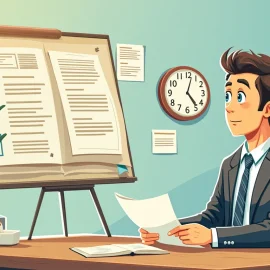

This article is an excerpt from the Shortform summary of "Getting Things Done" by David Allen. Shortform has the world's best summaries of books you should be reading.
Like this article? Sign up for a free trial here .
Are you looking for Getting Things Done (GTD) techniques that can help you in the Getting Things Done system to stay organized?
These top Getting Things Done techniques are perfect to keep in mind when you’re working through the GTD system, and applying it to your life. These Getting Things Done techniques can help you stay focused and get things done.
GTD Techniques: Mastering the Basics
As we’ve talked about, implementing and mastering the GTD program will be a lifelong endeavor—you’ll never reach an endpoint but rather, over time, you’ll become more proficient at using the GTD system and can leverage it to accomplish more profound productivity.
Think of it like learning to play guitar: First, you learn the chords, then, as those become more second-nature, you learn simple melodies, and finally, you can compose your own music. These Getting Things Done (GTD) techniques can help you get there.
Let’s explore the three tiers of GTD mastery.
Tier 1: The Fundamentals
Like any skill, the first step to mastering the GTD system is to get a grasp of the basics. These GTD tools and techniques can help you master the program.
Although the GTD program doesn’t require any new skills (for example, you know how to write things down and file papers), it does require you to adopt new practices and form new habits. It can easily take about two years to cement these habits, and most people fall off the wagon and get back on course a couple of times along the way.
Don’t let these basic practices slip, since they cause your whole system to unravel:
- Capturing items as soon as you receive them
- Diligently identifying next actions
- Keeping your Waiting For list complete and current, regularly reviewing it, and determining follow-up next actions when necessary
- Maintaining Agenda lists with discussion topics for various people in your life
- Maintaining a simple and navigable filing system
- Writing only date-specific tasks and reminders on your calendar
- Committing to a Weekly Review
Avoid these pitfalls and stay diligent about the Getting Things Done technques and you’ll reach the next level of GTD mastery.
Tier 2: Effective Life Management
While Tier 1 gives you full control of your hourly and daily tasks and schedule, at Tier 2 you’re managing your life at a weekly and monthly level. In other words, Tier 1 is about mastering your next actions, while Tier 2 is about mastering your projects. You should focus on GTD tools and techniques from both tiers to master the program.
Once you have a handle on all your action items, you can focus on the reasons behind those actions—the projects. Your projects are tied to your various roles and responsibilities, so this focus on Horizons 1 and 2 helps you ensure that every demand on your time aligns with your values and goals.
You’ve achieved Tier 2 mastery when:
- You have a complete and updated Projects list. At this level, create a project to address anything that’s pulling at your attention, even relatively subtle and abstract issues like improving a relationship.
- You have a complete and current list of your roles, responsibilities, and interests in all areas of your life. When you have and review this list, identify improvements you want to make within those roles and responsibilities and turn those into projects.
- You’ve tailored the GTD system to fit your lifestyle, needs, and life direction beyond daily tasks. At this point, you’ve internalized the practices and elements of the GTD system and use the system without thinking about it.
- You respond to challenges in life by leaning more heavily on the GTD system, rather than straying from it. You recognize that the GTD system allows you to handle unexpected challenges more effectively, and you’re no longer tempted to revert back to past habits.
Tier 3: Optimization
At Tier 3, you’re not just using the guitar to play someone else’s songs—you’re making your own music. At this level of mastery, you’re using the GTD system to optimize your life, and have a firm understanding of GTD tools and techniques.
There are two aspects of this optimization. First, you can dedicate time to things that are meaningful to you. At this point, your daily and weekly tasks are under control, freeing up both time and mental energy. Now, add pipedream items to your in-tray because you have the system to process and execute them.
Second, use your distraction-free mind to come up with creative new ideas and productive actions. Have you ever been sorting through old contacts and came across a name that made you think, “I should contact this person and update her about the work I’m doing now”? At this stage, you can actually do all those kinds of small actions that get easily pushed aside but have the potential to produce tremendous results.
At this tier, come up with ways you can use the GTD system and Getting Things Done techniques to not only manage but improve your life. Rely on checklists to make sure your life is as well-rounded as you want it to be. Set reminders to check in on family members and touch base with old friends. Create a list of your most important professional contacts. Regularly review inspirational writings and affirmations.
Mastering the GTD program at this level goes beyond dealing with items that life presents to you and allows you to set your own agenda.
Create Checklists
Another one of the most useful Getting Things Done (GTD) techniques is checklists. Use checklists in two ways to further keep your mind clear and stress-free.
First, create checklists for broad areas of your life—like maintaining good physical health and keeping motivation and morale up among your team at work—so that you can regularly review and confirm that you’re still attending to that priority.
Checklist items like these often encompass items for your Projects list and Next Actions list (for example, creating an exercise regimen or planning a team-building activity), but as those particular tasks vary use your checklist to ensure you’re staying on top of things in that general area.
Consider creating checklists that pertain to these areas of your life:
- Career goals
- Creative endeavors
- Family
- Finances
- Health and well-being
- Relationships
Second, you can use checklists to help you remember a sequence of steps or the various components of something, the way you would use a recipe. Examples of this include:
- Instructions for fixing a recurring tech problem
- Job duties when you’re new to a position
- All the steps of a new workflow you’re implementing
- Items to pack on every trip you take
- Everything you need to review and update during your Weekly Review
Keep your checklists current and relevant by creating them and tossing them whenever appropriate. (Shortform note: For more on the benefits of checklists and how to create them, read our summary of The Checklist Manifesto here.)
Of course, these are not the only Getting Things Done (GTD) techniques you should be paying attention to. There are plenty of Getting Things Done techniques to help you master the system in no time.

———End of Preview———
Like what you just read? Read the rest of the world's best summary of David Allen's "Getting Things Done" at Shortform .
Here's what you'll find in our full Getting Things Done summary :
- Why you're disorganized and your to-do list is a mess
- The simple workflow you can do everyday to be more productive than ever
- How to take complicated projects and simplify them






